You shouldn't cure soap near windows because they create inconsistent conditions that harm your soap's quality. Windows cause temperature fluctuations, humidity changes, and expose soap to damaging UV rays that accelerate uneven water evaporation. The direct sunlight fades fragrances, alters colors, and disrupts proper saponification. Additionally, windows allow dust, pollen, and other contaminants to settle on your bars. Proper curing requires controlled environments where your handcrafted bars can develop their ideal properties.
Why Should You Never Cure Soap Near Windows?
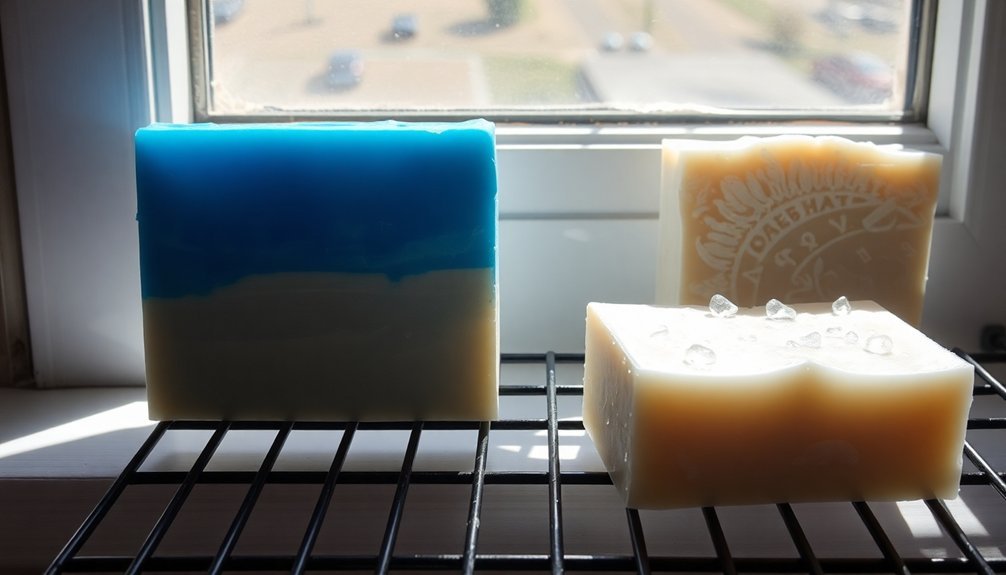
While soap making is a rewarding craft, curing your freshly made soap near windows can sabotage the quality of your final product.
Windows create unstable environments with fluctuating humidity and temperature levels that interfere with proper water evaporation from your soaps.
When you place soap near windows, you're exposing it to inconsistent airflow and potential moisture intrusion that slows down curing times.
External pollutants and dust particles can enter through windows and settle on your soap's surface, resulting in blemishes or impurities. Using a gauze tent can help protect your curing soap from dust while still allowing air circulation.
Additionally, the variable conditions near windows can disrupt the soap's crystalline structure development, affecting both functionality and appearance.
For better results, cure your soaps in controlled environments away from windows, using fans or ventilation systems that provide consistent air circulation without introducing external contaminants.
The Hidden Dangers of Direct Sunlight on Curing Soap
Direct sunlight poses several significant threats to your soap during the crucial curing phase. When you place your freshly made bars near windows, UV rays accelerate water evaporation unevenly, leading to cracking and premature breaking.
The sun's radiation degrades essential oils and herbs in your soap, diminishing their therapeutic benefits and hastening fragrance loss. You'll also notice your carefully crafted colors fading or changing as UV light destabilizes pigments.
Temperature fluctuations near windows disrupt the consistent environment needed for proper curing. This affects your soap's molecular structure, potentially compromising lather quality and overall stability. Proper curing ensures your soap completes saponification reaction and transforms into a safe product for skin use.
Even if your soap fully cures, its texture, appearance, and performance will be compromised.
For best results, always cure your soaps in dark, well-ventilated spaces with stable temperatures between 65°F and 75°F.
How Window Humidity Affects Soap's Moisture Content

Window areas often trap steam and moisture that can penetrate your soap, considerably slowing the evaporation process essential for proper curing. Running a fan over soap can significantly speed up the drying process and counteract the negative effects of window humidity.
The condensation that forms on glass surfaces creates micro-humidity zones that interfere with saponification, extending your cure time beyond normal expectations.
This excess moisture doesn't just affect curing time—it'll also impact your soap's lathering properties, potentially leaving you with a product that performs below its potential.
Trapped Steam and Evaporation
Three critical humidity factors converge near windows that can greatly impair your soap's curing process. When steam gets trapped near windows, it creates a moisture-rich environment that prevents proper water evaporation from your soap. This higher humidity level slows down the curing process and can markedly reduce your final product's quality. Just as scientific studies have revealed hidden dangers in common chemicals, proper soap curing requires careful attention to environmental conditions.
| Issue | Near Window | Away from Window |
|---|---|---|
| Steam Trapping | High due to reflection | Minimal |
| Evaporation Rate | Slower | Faster |
| Moisture Content | Higher | Lower |
| Soap Quality | Reduced longevity | Ideal hardness |
Proper ventilation is essential if you must cure soap near windows. Consider using dehumidifiers to combat moisture accumulation, especially in humid climates. You'll achieve better results by positioning your curing racks away from windows where airflow is consistent and humidity levels remain stable.
Condensation Slows Saponification
When condensation forms near windows, it greatly interferes with soap's saponification process, the critical chemical reaction that transforms oils and lye into soap.
This chemical transformation can't properly complete when excess moisture is present, as your soap will continuously draw in humidity from the window area.
Natural glycerin in handmade soap acts as a humectant, attracting even more moisture from the air. Proper storage in a cool, dry place away from windows prevents excessive sweating that can compromise soap quality.
Your soaps with additives like honey or sea salt are particularly vulnerable due to enhanced humectant properties.
Temperature fluctuations near windows compound this problem, impeding the gel phase and altering your soap's texture.
You'll notice your soap appears to "sweat" in these conditions, signaling that saponification is being compromised.
For properly cured soap, move your drying racks away from windows and consider using dehumidifiers in your curing area.
Humidity's Lather Impact
The moisture content of your soap dramatically changes when cured near windows, directly impacting its lathering qualities. High humidity near windows disrupts the delicate balance of moisture needed for peak lather formation.
Your soap's ability to trap dirt becomes compromised as excess moisture affects the bubble structure essential for effective cleaning.
Window areas create problematic conditions where soapy water films become unstable, resulting in less robust lather. You'll notice diminished bubble stability and altered texture in soaps cured in these humid environments.
This moisture imbalance not only affects performance but also changes how the soap feels on your skin after use. Ideal curing requires proper evaporation of excess liquid, which is severely hindered by the Florida-like conditions near windows, particularly in humid climates.
To preserve ideal lathering properties, choose curing locations away from windows, use dehumidifiers when necessary, and consider water discounting in your recipes during humid seasons.
Temperature Fluctuations: The Window-Induced Enemy of Soap
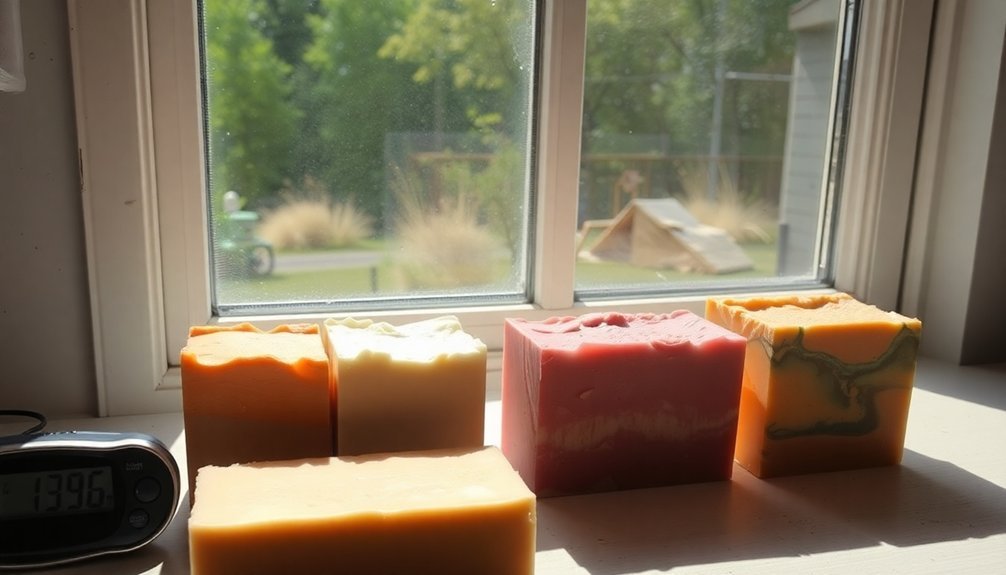
Windows create dramatic temperature swings that wreak havoc on your curing soap, with daytime heat waves potentially causing "alien brain" textures and glycerin rivers.
When night falls, cold drafts from the same windows can greatly slow down your soap's curing process, extending your wait time by weeks.
You'll achieve more consistent results by placing your soap in a location with stable temperatures away from the unpredictable conditions windows create. The ideal environment maintains good air circulation throughout the curing period, which windows cannot reliably provide.
Temperature Fluctuations: The Window-Induced Enemy of Soap
Temperature fluctuations represent perhaps the most significant challenge for soap makers who unwisely position their creations near windows. Your carefully crafted soaps can experience dramatic temperature changes throughout the day as windows transfer both heat and cold from the outside environment.
When your soap bars endure these fluctuations, they may enter an unwanted gel phase during hot periods, resulting in altered appearance and texture. In colder spells, your soaps might cure more slowly or unevenly. These inconsistencies directly impact the quality of your final product.
This is especially problematic in warmer climates, where window proximity can cause soap to overheat rapidly. The extreme heat can trigger unwanted soap volcanoes as the mixture expands uncontrollably due to accelerated chemical reactions. Even in moderate climates, the daily heating and cooling cycle disrupts the stable environment needed for proper curing.
You'll achieve more consistent results by moving your soap to interior locations with steady temperatures.
Heat Waves Damage Texture
Heat waves present a particular threat to soap texture when curing occurs near windows.
When your soap is exposed to intense sunlight, the high temperatures can dramatically alter the oils and butters in your creation, causing unwanted consistency changes and surface distortions.
The excessive heat accelerates saponification, potentially triggering the dreaded "alien brains" effect on your soap's surface.
High-water soap recipes are particularly vulnerable to developing puffing and blistering when subjected to temperature fluctuations near windows.
Water expansion within your bars creates unsightly texture problems, especially in recipes with higher water content.
Even more concerning, extreme temperatures can break chemical bonds in your soap ingredients, compromising their performance.
To protect your craft, consider cooling techniques like refrigeration after pouring when temperatures soar, and always cure your soap away from direct heat sources to guarantee uniform temperature distribution and preserve your soap's intended texture.
Cold Drafts Hinder Curing
While many soapmakers focus on avoiding excessive heat, cold drafts near windows pose an equally serious threat to your curing soap.
These drafts create temperature fluctuations that disrupt the even drying process, resulting in inconsistently cured bars with varied hardness levels.
When cold air sweeps across your soap, it slows water evaporation and extends curing time considerably.
The unpredictable airflow near windows interrupts the delicate precipitation crystallization process that gives soap its proper texture.
You'll notice the difference in quality when your bars cure unevenly.
Experiments have shown that proper temperature control is essential since increased temperature results in higher water loss rates during the curing process.
What's worse, these drafts can carry additional humidity, creating moisture accumulation that persists even after you believe curing is complete.
For ideal results, place your soap away from windows in a climate-controlled environment where temperature and humidity remain stable.
Dust and Contaminants: When Windows Become Soap's Nemesis
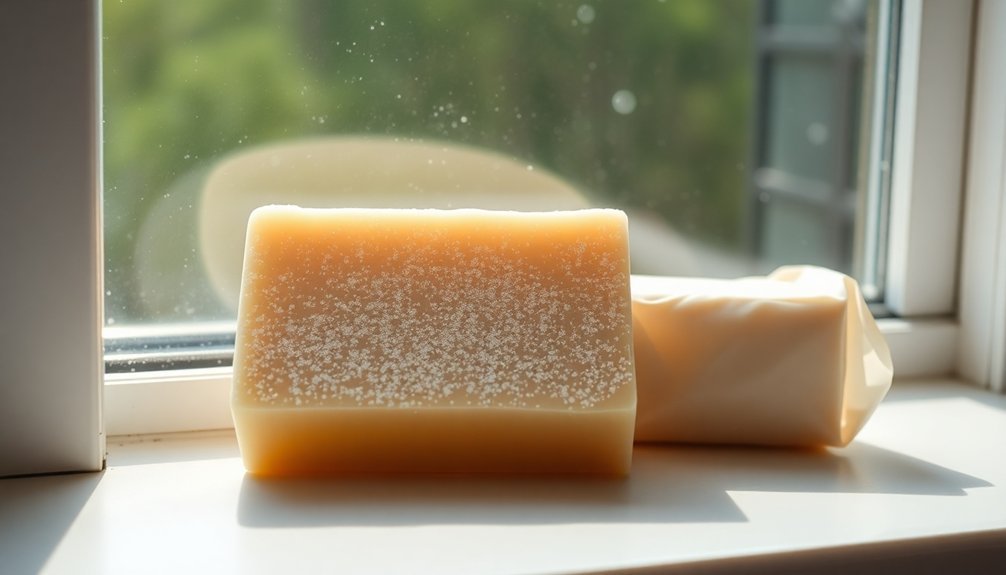
When you cure soap near windows, you're fundamentally inviting a host of unwanted guests to your crafting party. Dust, pollen, and other airborne allergens can settle on your soap's surface, compromising both its appearance and structural integrity.
- Airborne contaminants introduce unwanted particles that affect texture and color.
- Open windows allow insects to enter and contaminate your soap.
- Moisture from outside can promote mold growth and soften your product.
- Allergens that settle on soap may cause skin reactions in sensitive individuals.
- Contaminants from window frames and sills introduce additional impurities.
Keeping windows closed during the curing process is essential for maintaining soap quality. The residue from soap may create an unsightly film on windows that attracts dirt and is difficult to remove completely.
If ventilation is necessary, consider using air purifiers and covering your soap with breathable materials to minimize contamination risk.
The Science of Air Circulation in Soap Curing Environments
Windows create problematic temperature gradients that disrupt the even curing of your soap bars.
You'll notice air stagnation zones forming near window areas, especially during temperature fluctuations throughout the day.
The resulting irregular airflow patterns can leave some portions of your soap under-cured while over-drying others, compromising the overall quality of your handcrafted products. For proper curing, soap requires open air exposure to facilitate water evaporation and the crystallization process.
Optimal Airflow Patterns
Three key elements define effective air circulation for soap curing: consistency, gentleness, and proper distribution.
Creating the right airflow environment helps your soap develop its crystalline structure while preventing case hardening from overly rapid drying.
The ideal air circulation pattern should include:
- Cross-ventilation that moves air horizontally across soap racks
- Upward flow patterns that carry moisture away from curing bars
- Gentle movement that doesn't create concentrated air jets
- Consistent circulation that avoids stagnant pockets of humidity
- Room-temperature flow that doesn't introduce extreme temperature changes
You'll achieve best results using slotted racks with bars placed an inch apart, allowing air to flow around each soap surface. This proper spacing creates optimal airflow similar to the recommended storage on wire racks mentioned in ideal curing conditions.
A small oscillating fan positioned away from direct contact with your soaps can maintain this effective circulation pattern without causing uneven drying.
Air Stagnation Issues
Despite appearances, air near windows isn't always in motion, creating deceptive stagnation zones that can sabotage your soap curing process.
These pockets of still air form when furniture or walls block natural airflow, trapping moisture around your curing soap.
When air doesn't circulate properly, your soap retains excess moisture, becoming a perfect breeding ground for mold and bacteria.
This stagnation prevents even drying, leaving you with inconsistent bars featuring soft spots or uneven textures.
Additionally, windows expose your soap to fluctuating temperatures and humidity levels from outdoors, further complicating the curing process.
Window areas also tend to accumulate dust particles that settle on your soap, creating an unappealing appearance and potentially compromising quality.
To avoid these issues, choose curing locations with consistent airflow away from windows. Using open racks for curing your soaps will significantly improve airflow and ensure proper drying in a well-ventilated area.
Temperature Gradient Effects
When you place soap near windows, you're unwittingly creating a scientific experiment in temperature dynamics that can ruin your batch.
Windows create temperature fluctuations that affect essential aspects of the curing process.
Temperature gradients near windows can cause:
- Uneven curing with one side hardening faster than the other
- Gel phase issues when soap experiences shifting heat levels
- Glycerin rivers forming as rapid temperature changes affect crystallization
- Soda ash development on surfaces exposed to fluctuating conditions
- Color distortion in pigments sensitive to temperature variations
The ideal curing temperature ranges between 70-75°F, which is difficult to maintain near windows where temperatures constantly shift. Saponification is fundamentally an exothermic reaction that requires stable environmental conditions to proceed properly.
Your soap needs stable conditions to properly saponify and cure, and window areas simply can't provide the consistency required for quality results.
Seasonal Challenges: Summer Heat vs. Winter Drafts From Windows
The changing seasons present unique challenges for soap makers who cure their products near windows.
During summer, excessive heat can disrupt even curing, accelerate essential oil evaporation, create uneven textures, and increase oxidation rates. High humidity levels further complicate the drying process.
Winter brings its own problems as drafts cause uneven drying and inconsistent curing. Indoor heating systems lower moisture levels, potentially drying soap too quickly, while cold temperatures can extend curing times.
Both seasons might require different mitigation strategies.
For summer, use dehumidifiers, provide shade, and guarantee proper air circulation.
In winter, install draft stoppers or partitions, but avoid space heaters near curing soap.
Throughout the year, consider alternatives like well-ventilated rooms away from windows or purpose-built curing cabinets with controlled conditions.
Preventing "Alien Brain" Syndrome in Cold-Process Soap
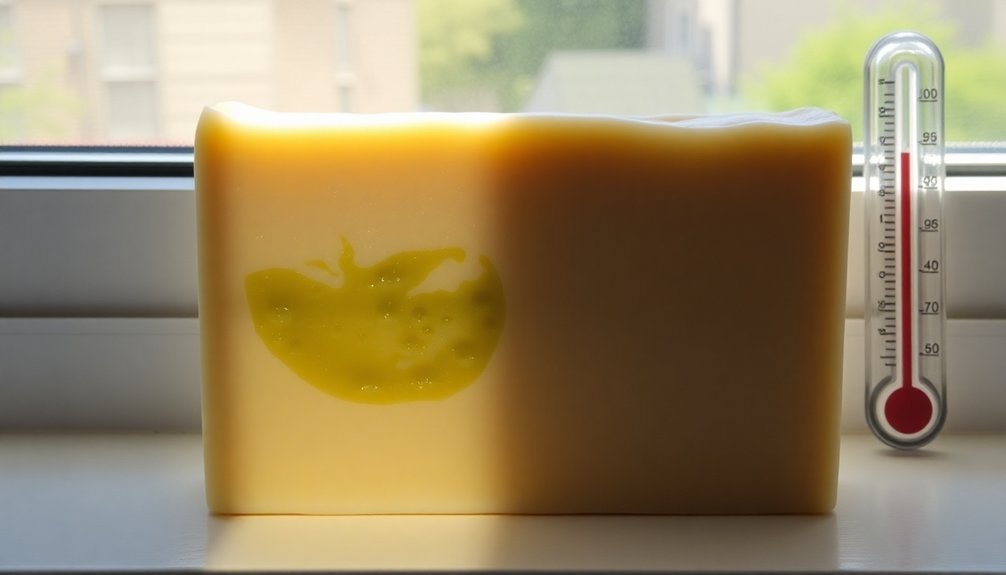
Among the challenges soap makers face when curing near windows, perhaps none is more visually distinctive than "Alien Brain" syndrome. This cosmetic issue creates a wrinkled, rippled surface on your soap—the result of overheating during the curing process.
Windows create temperature fluctuations that can trigger this phenomenon, especially in soaps containing natural sugars like honey or milk.
To prevent this unsightly effect while curing soap, you should:
- Keep soap away from windows to maintain stable temperatures
- Monitor soap temperature regularly with a reliable thermometer
- Reduce or modify recipes containing heat-accelerating ingredients
- Consider using the CPOP method for controlled temperature curing
- Create a dedicated curing space with consistent environmental conditions
Though "Alien Brain" doesn't affect soap usability, preventing it guarantees your handcrafted products look as good as they perform.
Optimal Curing Conditions for Maximum Soap Longevity
Creating ideal curing conditions stands as the foundation for maximizing your handmade soap's longevity. You'll want to maintain temperatures between 60°F and 80°F (15°C-27°C) while ensuring low humidity levels throughout the 4-6 week curing process.
Proper airflow is critical—use drying racks that allow circulation on all sides of your soap bars. This prevents moisture buildup that could lead to mushy texture or even mold growth.
Never place curing soap near windows where fluctuating temperatures, direct sunlight, and potentially higher humidity can disrupt the curing process.
For the longest-lasting bars, store fully cured soap in cool, dry places away from sunlight. Using soap dishes with good drainage during everyday use will further extend your soap's life by preventing it from sitting in water.
Window Placement and Its Impact on Saponification Completion
While most soapmakers understand the importance of curing, many don't realize that window placement can greatly impact the completion of saponification.
Windows introduce variables that can disrupt the delicate chemical processes occurring as your soap transforms from raw ingredients to finished product.
- Direct sunlight accelerates saponification too quickly, creating texture problems
- Temperature fluctuations near windows disrupt the ideal curing range
- Excess moisture from humid outdoor conditions can slow water evaporation
- Uneven exposure to heat can cause the "alien brains" aesthetic effect
- Inconsistent curing conditions lead to varying hardness levels across bars
Remember that saponification requires stable conditions to complete properly.
Creating the Ideal Indoor Curing Station Away From Windows
Now that we recognize why windows can interfere with saponification, let's examine how to set up your curing station properly.
Choose a quiet area with stable temperature and humidity levels, away from direct sunlight and moisture sources. This environment prevents glycerin rivers and maintains consistent texture in your soap.
For best results, guarantee adequate ventilation without drafts. You'll want good airflow around each bar, which you can achieve by properly spacing your soaps on wire racks, wooden pallets, or metal shelving.
Consider using fans to enhance circulation and dehumidifiers to manage moisture levels.
Organize your station efficiently with multi-level storage options. Label each batch with dates and ingredients for easy tracking.
This systematic approach not only maximizes your available space but also creates perfect conditions for your soap to cure properly.
Protecting Your Soap's Fragrance and Color From Window Elements
Fragrance and color preservation represent two of the most significant challenges for soap makers during the curing process.
When you cure soap near windows, you expose your creations to elements that can degrade their quality dramatically.
UV rays penetrating through glass will fade colors—especially natural pigments—and break down fragrance compounds faster than indoor ambient light.
Your window environment introduces several additional risks:
- Temperature fluctuations near windows accelerate fragrance degradation
- Airborne chemicals from traffic or industry can alter your soap's scent profile
- Humidity variations affect even drying, potentially trapping fragrance within soap
- Environmental odors can contaminate and compete with your soap's intended scent
- Dust particles entering through windows stick to moist soap, affecting appearance
Consider using protective coverings or relocating your curing station to preserve your soap's sensory qualities.
Monitoring Tools for Proper Soap Curing Environments
Successfully protecting your handmade soap extends beyond simply moving it away from windows—you'll need reliable tools to monitor your curing environment. Consistent tracking guarantees superior conditions for your soap's maturation process.
| Tool | Purpose |
|---|---|
| Hygrometer | Measures ambient humidity levels to prevent moisture absorption |
| Digital scale | Tracks weight loss to determine curing progress |
| Thermometer | Monitors temperature stability between 60-80°F |
| Data logger | Records environmental conditions over time |
Consider integrating these tools with spreadsheets or curing logs to analyze patterns. Test soap hardness regularly with gentle finger pressure and evaluate lather quality as curing progresses. For maximum control, pair monitoring with equipment like dehumidifiers or fans to maintain prime conditions, especially when local weather fluctuates.
Frequently Asked Questions
Can Uv-Blocking Window Film Protect Curing Soap?
UV-blocking window film offers significant protection for your curing soap by reducing harmful UV radiation, but it won't completely eliminate all risks. You'll still need to evaluate heat and indirect light exposure.
How Does Altitude Affect Soap Curing Near Windows?
At higher altitudes, you'll find lower humidity speeds up your soap's curing near windows, but you're also exposed to more intense UV radiation and temperature fluctuations that can affect quality and consistency.
Can Curing Near LED or Fluorescent Lights Cause Similar Issues?
LED and fluorescent lights won't cause the same issues as windows. They don't emit significant UV radiation or create temperature fluctuations. You'll face minimal impact on your soap's curing process when using these lighting options.
Is Window-Adjacent Curing Worse for Certain Soap Colorants?
Yes, window-adjacent curing affects certain colorants more severely. Natural dyes, micas, and ultramarines are particularly vulnerable to UV damage. You'll notice fading, discoloration, and uneven pigment distribution in these light-sensitive additives.
How Do Different Soap Molds Impact Window-Related Curing Problems?
Different molds impact curing differently near windows. Plastic and wooden molds trap moisture from humidity, silicone offers better airflow, while metal conducts temperature fluctuations rapidly. You'll need to adjust placement based on your mold material.
In Summary
While you might love your soap creations, don't let them near windows during curing. You'll risk color fading, warped shapes, and compromised quality from sunlight, humidity, and temperature swings. Instead, create a dedicated curing space in a stable environment away from windows. Your soap deserves protection as it transforms into the perfect bar you've worked so hard to create.

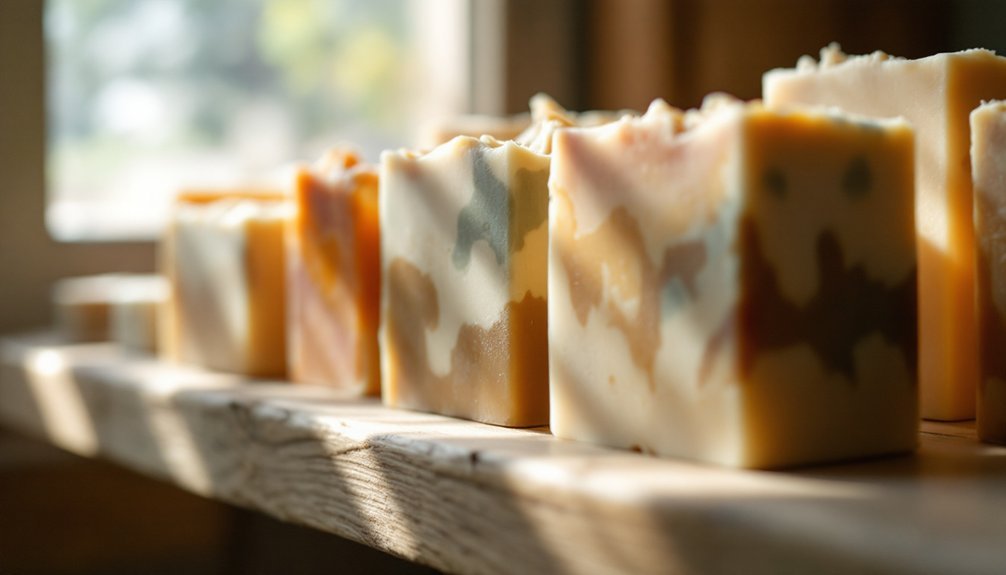



Leave a Reply